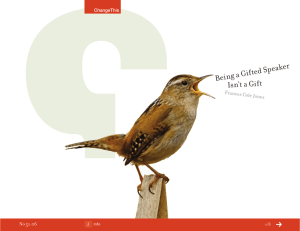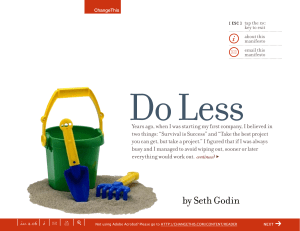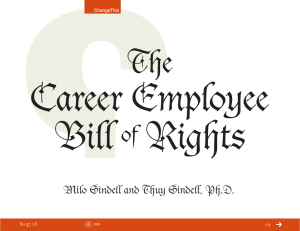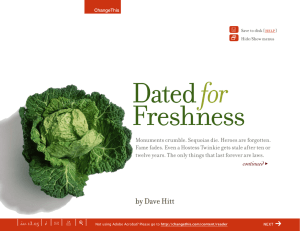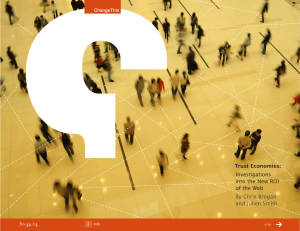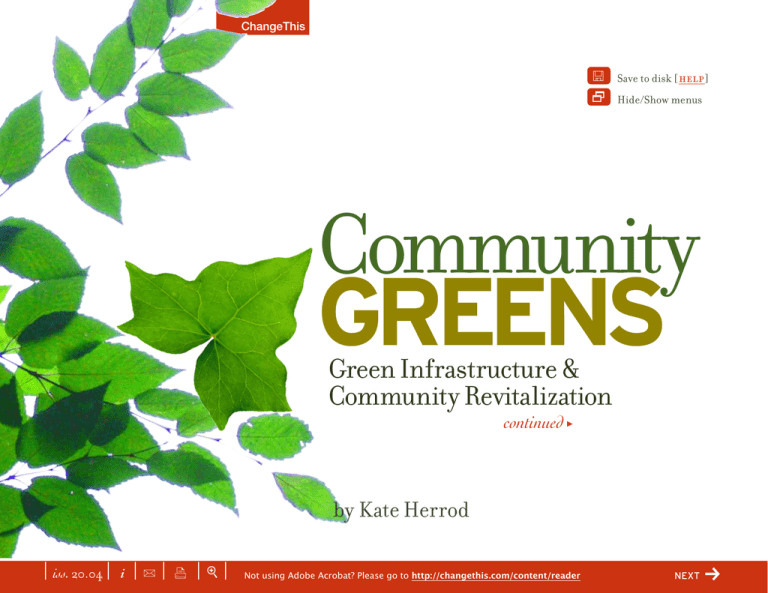
ChangeThis
Y
Save to disk [ help ]
2
Hide/Show menus
Community
Greens
Green Infrastructure &
Community Revitalization
continued >
by Kate Herrod
| iss. 20.04 | i | U |
x
|+|
Not using Adobe Acrobat? Please go to http://changethis.com/content/reader
next
f
ChangeThis
City Livin’
Have you ever lived in a neighborhood for a number of months or years, and never come to
know your neighbors? Do you ever wish that you owned a house in the country or better yet
could step into nature right outside your door? Does growing your own food appeal to you,
but you don’t get enough sun in your postage stamp-sized city-backyard? Is spending time
in a park something you love, but you find that it is too much of a hassle to drive there or
that when you do, it is being loved to death and is overrun with people?
Well, you’re not alone. As most of us know, many of the metropolitan areas in the United
States have become undesirable places to live. Cities seem to be perpetually plagued with
crime, grit, and anonymity. The suburbs, once heralded as an alternative to city living, are
experiencing the same kinds of problems that were once considered unique to major metro
areas. In addition, the sprawl that has resulted from the unplanned expansion of suburbs has
led to record commute times for workers, increasing stress, road rage and pollution, along
with diminished time available for family life. The lack of green space in cities also exacts a
toll. Scientific studies have shown that a dearth of green space can increase aggression and
violence. Because of inadequate impervious surface areas and trees, cities around the country
have failed to meet federal clean air and water standards and suffer from elevated temperatures in the summer (the “urban heat island effect”).
Much good thought is being given as to how to best design — or redesign — our cities. We
hear a lot about smart growth, new urbanism, green building, and sustainable communities,
all of which are steps in the right direction. Yet, there is one simple and effective tool that can
help invigorate cities and create community, improve the environment, and act as a bulwark
against sprawl.
What is this surprisingly powerful device? Community greens.
| iss. 20.04 | i | U |
x
|+|
h
/11
f
ChangeThis
Community greens are shared gardens on the inside of city blocks, created when neighbors
merge parts (or all) of their backyards to create resplendent shared outdoor spaces. They can
also be created when citizens reclaim underutilized government land – such as vacant lots,
abandoned homes, or alleyways. “Defensible” spaces, they are communally used and managed only by the residents whose homes abut them. They are not a public park, nor a private
backyard nor a community garden; however, they function as all three. They are a twist on
the ancient notion of the commons, updated to meet the demands of the modern world.
For centuries, communities grew up around these types of central commons or village
squares – where people would graze their livestock, mingle amongst one another, or create
marketplaces. The rise of the modern city — inexorably linked to a car-oriented culture — did
away with many of these spaces. Nonetheless, the need for communal spaces is alive and well
and these “one block commons” may be one of the most efficient and useful means of satisfying this inherent human need and at the same time improve the fabric of urban life.
A number of cities in Europe still have these secret gardens, and some savvy “early adapters”
here in the United States are changing the framework of existing neighborhoods and new
real estate developments to include them. The reason for their popularity is their beauty and
startling benefits.
Why Community Greens
From talking with residents lucky enough to live on a community green, we know that a
special sense of community is felt between neighbors that is non-existent in other living
arrangements. The greens, if well designed and managed, bring people together and keep
them together. Adults use community greens to relax at the end of a busy workday, socialize with their neighbors or have friends over for special events. Kids have play spaces right
| iss. 20.04 | i | U |
x
|+|
h
/11
f
ChangeThis
outside their backdoor, which is important in fighting childhood obesity. These greens also
become vehicles that enhance civic participation. People who organize their block to create a
green find themselves taking on greater civic leadership roles in their neighborhood.
Because community greens are rare amenities, people don’t often leave them, since the experience is so hard to duplicate elsewhere. This lack of turnover on a block adds to the social
cohesion and stability in a neighborhood.
Since community greens foster neighborliness, residents are very aware who is or is not a
part of their one-block common. And since neighbors tend to look out for one another when
they know each other, strangers are immediately spotted and crime is reduced. “Eyes on the
green” really do work and result in a greater sense of security.
Community greens help Mother Nature as well. They mitigate storm water run off, especially
if they are created where impervious surface areas used to exist. They reduce the urban heat
island effect through the planting of trees and shrubs and lead to lower air conditioning and
energy usage during the summer. They help clean the air of particulate matter. They also
serve as micro-habitats for insects and migrating birds.
Since community greens are such unique amenities, they enhance home values by approximately 5 –15%. Some real estate developers are including them in every development they
build since sales occur faster and at higher prices. In addition, because of enhanced homes
values, real estate tax revenues rise, so, in fact, they benefit an entire community.
Furthermore, they serve as a kind of frontline in urban agriculture, providing food security
for urban residents, especially those in areas without grocery stores.
In essence, cities become more liveable when community greens are incorporated into them.
| iss. 20.04 | i | U |
x
|+|
Be bold. Dream up your own manifesto and submit your idea here.
h
/11
f
ChangeThis
Even Science is Taking a Look
at Green Livin’
The psychological impact of living on green space, once just intuited as being “good”, is
now being categorized and quantified by scientists at the Human-Environment Research
Laboratory of the University of Illinois at Urbana-Champaign’s College of Agriculture,
Consumer and Environmental Sciences. Research has been undertaken to determine the
effects of green space on the residents of Chicago’s subsidized public housing projects. The
residents of the Chicago’s housing projects live in buildings that are similar except for the
amount and kinds of greens spaces that are part of the projects. Residents are randomly
assigned to the projects; hence, those who might relate to or use green space are not more
able to choose to live in a “greener” project than those who don’t care about such an amenity. Because of these factors, the projects serve as an effective place to measure differences
in residents’ behaviors.
After extensive research the team of scientists made some profound discoveries, namely:
| iss. 20.04 | i | U |
x
q
A direct correlation exists between green space and crime in inner city projects.
In fact, the greener the areas, the lower the crime.
w
Girls who can see trees or nature from their dwellings score higher on tests of concentration and self-discipline than those girls who don’t have access to such views.
e
Exposure to relatively small amounts of green space reduces mental exhaustion in
adults and aids them in recharging their focus, concentration, and ability to handle
life’s ups and downs.
|+|
h
/11
f
ChangeThis
r Children who play in green areas engage more frequently in “creative play” that they
make up, while children who play in barren areas engage in well-known “rule bound”
games such as cards or softball or tag. Children who play in green areas also have
more adult supervision and interaction, since adults tend to gravitate to green, not
barren, areas.
t Domestic partners’ aggressions are less in areas with greater amounts of green
spaces. When a number of residents were surveyed, 11% who lived in barren areas
stated that they had used a gun or knife at least once in their life during an argument
while only 3% of those who lived in greener conditions resorted to such behaviors.
When the scientists took their studies outside of Chicago projects and looked at ADD behavior in middle-class children, (family incomes of $50,000), they found that when children play
in green settings, their ADD symptoms are reduced. If children play indoors parents didn’t
report much relief of symptoms. The same held true for barren, hard surface play areas.
However, when children played in areas that had trees or grass, their symptoms were significantly reduced and for longer periods of time. a
It doesn’t take long to see that a reduction in municipal services (police calls, hospital visits,
and social workers) would be one of the direct impacts of greener spaces. The savings to
municipalities could be substantial. Frances Kuo, one of the lead scientists at the University
of Illinois, has suggested that public officials should work to “bring nature to every doorstep”
and she has called for cities to invest in “green relief”. In 1998 Chicago planted 20,000 trees
at a cost of $10,000,000 partially as a result of this research.
A http://www.herl.uiuc.edu/
| iss. 20.04 | i | U |
x
|+|
h
/11
f
ChangeThis
How to Get Started
The beauty of community greens — when created on a block that already has existing backyards — is their simplicity. All neighbors have to do is agree as to what kind of space to create and begin by tearing down their fences. If some neighbors have dogs, usage agreements
will need to be worked out. For those who don’t want dogs in their areas, electronic invisible
fencing might be called for. Liability is often a concern. If a homeowners’ association or LLC
is going to manage the green, then that entity should secure liability insurance. If not, each
homeowner can simply upgrade (or obtain) liability insurance.
Because community greens are clearly of such public benefit, it is a wonder that they are not
more present in existing cities and that there aren’t subsidies, tax credits, or other incentives
that would encourage their creation. Imagine if a number of these greens were strategically
placed throughout cities to encourage the reduction of storm water surges and air pollution,
reinforce green corridors, and provide places of respite for both adults and children. How
much better would our cities be?
Since most of us live in already existing neighborhoods, the more pressing question quickly
becomes: how can we as citizens and politicians encourage the development of community
greens? What kinds of incentives can be created to encourage the creation of these greens?
What should be given from state, county, or municipal governments to catalyze their
creation?
The solutions and incentives will vary from community to community. In some cities, tax
credits or tax deductions for the amount expended on creating a green or freezing residents’
real estate taxes for a period of years might work best. In other communities, simple changes
in zoning (density zoning bonuses, overlay zones) might encourage their creation.
| iss. 20.04 | i | U |
x
|+|
Want to copy and paste parts of this manifesto? Click here for instructions.
h
/11
f
ChangeThis
Some communities are already taking action. In Langley, Washington, the city needed to
create more market-rate affordable housing, so they passed a “cottage housing code” which
allowed small (approximately 975 square foot) cottages to be built in neighborhoods that
typically boasted much larger homes. The code stipulates that these cottage home developments must have green space that is bounded on a minimum of two sides by homes, where
at least 50% of the homes abut the green, and no home can be more than 60 feet walking
distance from the green.
In Baltimore, a grassroots movement has been started by residents to take back their alleys
and green them. Baltimore is a city that has lost significant population since the 1950’s and
many alleyways are crime-ridden and filled with trash. Working with non-profit partners
(including Community Greens) and pro-bono attorneys over a three-year period, residents
there have changed the city charter by passing a bill in the state legislature, giving the city
the right to lease alleys to entities consisting of residents on a block. The work continues.
Proponents are now creating an ordinance which will outline the process that residents must
follow if they choose to lease their alley from the city and then gate it and green it.
So What About Your Backyard?
So, imagine that when you came home after a busy day and walked outside your backdoor,
that you were greeted with a magnificent shared garden that took up most of the interior of
your block. Imagine that you came to know your neighbors…that you had a luxurious green
oasis in which to relax, grow vegetables, or have friends over for a gathering.
If you feel like learning more about how to create these secret gardens and see what other
people have done, check out the web site: www.communitygreens.org. It might be the first
step to improving your lifestyle, your block and your city.
| iss. 20.04 | i | U |
x
|+|
h
/11
f
ChangeThis
info
About the Author
Kate Herrod is Director of Community Greens, an initiative of the citizen sector organization Ashoka:
Innovators for the Public. Prior to joining Community Greens, Kate ran her own consulting business,
focusing on the non-profit arena. Clients included the California Center for Land Recycling, The
Trust for Public Land, Cameroon Mountains Conservation Foundation, the International Sustainable
Development Foundation, Ashoka: Innovators for the Public, and Get America Working. For several
years prior to starting her own business, Ms. Herrod was the Deputy Director of Development for The
Nature Conservancy. She also spent over a decade in the private sector as Vice President for com-
mercial real estate finance with Citibank, Chemical, and Security Pacific banks on the east and west
coasts. She is a graduate of Amherst College and the Wharton School of Business. She dreams of
greening cities all across America. http://communitygreens.org
download this
This manifesto is available from http://changethis.com/20.CommunityGreens
send this Click here to pass along a copy of this manifesto to others.
http://changethis.com/20.CommunityGreens/email
Subscribe
Learn about our latest manifestos as soon as they are available. Sign up for our free newsletter and
be notified by email. http://changethis.com/subscribe
z
| iss. 20.04 | i | U |
x
|+|
last page read
h
| more
/11
f
f
ChangeThis
info
WHAT YOU CAN DO
You are given the unlimited right to print this manifesto and to distribute it electronically (via email,
your website, or any other means). You can print out pages and put them in your favorite coffee shop’s
windows or your doctor’s waiting room. You can transcribe the author’s words onto the sidewalk, or
you can hand out copies to everyone you meet. You may not alter this manifesto in any way, though,
and you may not charge for it.
Navigation & User Tips Move around this manifesto by using your keyboard arrow keys or click on the right arrow ( f ) for
the next page and the left arrow ( h ). To send this by email, just click on
U
.
Having problems saving to disk? First, make sure you have the latest version of Acrobat Reader 6 which you can download from
http://www.adobe.com/products/acrobat/readstep2.html. If problems persist, it may be due to your
Acrobat Reader settings. To correct the problem (for Windows), a reader, J. Hansen, suggests going
to your Acrobat Reader Preferences > Options > Web browser Options. Check the “Display PDF in
Browser” option. Then click on Save to Disk
Y
.
keyboard shortcuts
pc
mac
Zoom in (Larger view)
[ ctl ] [ + ] [
Full screen/Normal screen view
[ ctl ] [ L ] Zoom out
#]
[#]
[#]
[ ctl ] [ — ] z
| iss. 20.04 | i | U |
x
|+|
[+]
[—]
[L]
last page read
h
| more
10/11
f
f
ChangeThis
info
Born on date
This document was created on 14 December 2005 and is based on the best information
available at that time. To check for updates, please click here to visit http://changethis.com/20.
CommunityGreens
some rights reserved
cc creative
commons
Copyright info
The copyright in this work belongs to the author, who is solely responsible for the content. Please
direct content feedback or permissions questions to the author: kherrod@ashoka.org
This work is licensed under the Creative Commons Attribution-NonCommercial-NoDerivs License.
To view a copy of this license, visit http://creativecommons.org/licenses/by-nc-nd/2.5 or send a
letter to Creative Commons, 559 Nathan Abbott Way, Stanford, California 94305, USA.
Cover image from http://shutterstock.com
ABOUT CHANGETHIS
ChangeThis is a vehicle, not a publisher. We make it easy for big ideas to spread. While the authors
we work with are responsible for their own work, they don’t necessarily agree with everything
available in ChangeThis format. But you knew that already.
ChangeThis is supported by the love and tender care of 800-CEO-READ. Visit us at main site
www.800ceoread.com or at our daily blog blog.800ceoread.com.
z
| iss. 20.04 | i | U |
x
|+|
last page read
h
11/11


